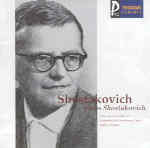Had he wished, Dmitri Shostakovich could have made a career as a virtuoso pianist. Certainly he kept up his technique enough to play his two concertos at breakneck speeds, as his Russian recordings of these works prove. Tempos are quicker than in his cleaner, superior-sounding Paris recordings for EMI under Cluytens, and accentuation is more aggressive (the second concerto’s outer movements, for example). But sonic and executional problems persist. In the first concerto, the scruffy Moscow Philharmonic musicians keep up by the skin of their collective teeth. That is to say, when you can hear them, for the composer is balanced so far forward that you wonder if the engineer had stuffed a microphone smack dab into the soundboard and way too close to the awful trumpet soloist. And the ill-tuned winds in the second concerto easily yield to their piquant French counterparts. Still, any pianist taking up these works should hear the solo parts delivered from the horse’s mouth, so to speak.
A delightful, unbuttoned performance of the eight-minute Concertino for two pianos features the composer’s son Maxim at the second keyboard. Shostakovich is on his best pianistic form in the famous 1946 recording of the second piano trio, where violinist David Oistrakh and cellist Milos Sadlo collaborate with sensitivity and verve. It’s a steadier, better-controlled interpretation than the recording preserving Shostakovich and the work’s creators (violinist Dmitri Tsiganov and cellist Sergei Shrinsky). If anyone cares, Yedang’s transfers are slightly fuller than the identical program released on the discontinued Revelation label.
































